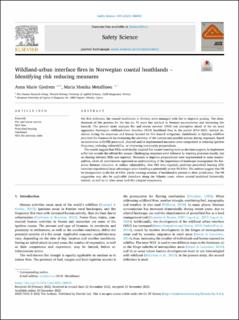| dc.contributor.author | Gjedrem, Anna Marie | |
| dc.contributor.author | Log, Maria-Monika Metallinou | |
| dc.date.accessioned | 2023-04-12T11:03:15Z | |
| dc.date.available | 2023-04-12T11:03:15Z | |
| dc.date.created | 2023-03-14T09:35:54Z | |
| dc.date.issued | 2023 | |
| dc.identifier.citation | Safety Science. 2023, 159:106032. | en_US |
| dc.identifier.issn | 0925-7535 | |
| dc.identifier.uri | https://hdl.handle.net/11250/3062621 | |
| dc.description.abstract | For five millennia, the coastal heathlands in Norway were managed with fire to improve grazing. The abandonment of this practice for the last ca. 70 years has resulted in biomass accumulation and increasing fire hazards. The present study analyses fire and rescue services’ (FRS) risk perception ahead of the six most aggressive Norwegian wildland-urban interface (WUI) heathland fires in the period 2014–2021, tactical decisions during the responses and lessons learned for fire hazard mitigation. Guidebooks in fighting wildfires provided the framework for evaluating the adversity of the context and possible actions during responses. Based on interviews with FRS personnel, planned and/or implemented measures were categorized as reducing ignition frequency, reducing vulnerability, or improving community preparedness.
The results suggest that FRSs need locally adapted fire hazard warning tools as decision support, to implement a fire ban outside the official fire season. Challenging responses were followed by learning processes locally, but no sharing between FRSs was reported. Measures to improve preparedness were implemented in some municipalities, while all interviewees expressed an understanding of the importance of landscape management for fire-prone biomass reduction, to reduce vulnerability. One FRS who regularly performs prescribed burning (PB) exercises experienced large advantages when handling a potentially severe WUI fire. The authors suggest that PB be incorporated in the list of FRSs’ yearly training sessions, if heathland is present in their jurisdiction. The PB suggestion may also be applicable elsewhere along the Atlantic coast, where coastal heathland historically existed, as well as in other areas with fire-adapted ecosystems. | en_US |
| dc.language.iso | eng | en_US |
| dc.publisher | Elsevier | en_US |
| dc.rights | Navngivelse 4.0 Internasjonal | * |
| dc.rights.uri | http://creativecommons.org/licenses/by/4.0/deed.no | * |
| dc.title | Wildland-urban interface fires in Norwegian coastal heathlands – Identifying risk reducing measures | en_US |
| dc.type | Peer reviewed | en_US |
| dc.type | Journal article | en_US |
| dc.description.version | publishedVersion | en_US |
| dc.rights.holder | © 2022 The Authors. | en_US |
| dc.source.volume | 159 | en_US |
| dc.source.journal | Safety Science | en_US |
| dc.identifier.doi | 10.1016/j.ssci.2022.106032 | |
| dc.identifier.cristin | 2133679 | |
| dc.relation.project | Norges forskningsråd: 298993 | en_US |
| dc.source.articlenumber | 106032 | en_US |
| cristin.ispublished | true | |
| cristin.fulltext | original | |
| cristin.qualitycode | 2 | |

